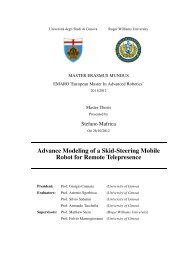East Bay Coalition for the Homeless - Roger Williams University
East Bay Coalition for the Homeless - Roger Williams University
East Bay Coalition for the Homeless - Roger Williams University
You also want an ePaper? Increase the reach of your titles
YUMPU automatically turns print PDFs into web optimized ePapers that Google loves.
5. Networked nonprofits know how to inspire people. Networked nonprofits motivate <strong>the</strong>ir networks of support<br />
to help shape <strong>the</strong> organization’s programs, to share <strong>the</strong>ir stories in order to raise awareness of social issues, to change<br />
attitudes and behavior, and to organize communities to provide services or advocate <strong>for</strong> legislation.<br />
6. Networked nonprofits work differently. They enjoy a social culture that encourages everyone in and outside <strong>the</strong><br />
organization to participate and spread <strong>the</strong> organization’s mission. They have challenged deep-set organizational assumptions<br />
about leadership, roles, and structures. They have broken down departmental silos. They are com<strong>for</strong>table<br />
sharing control or co-creating with <strong>the</strong>ir networks—whe<strong>the</strong>r that means allowing people to reteil <strong>the</strong> organization’s<br />
story in <strong>the</strong>ir own words or scaling programs.<br />
7. Networked nonprofits are masters at using social media. They are adept at using tools that encourage conversations<br />
and building relationships between people, and between people and organizations. They are able to scale <strong>the</strong>ir<br />
ef<strong>for</strong>ts quickly, easily, and inexpensively. Networked nonprofits are adept at blending tried and true methods with<br />
new digital tools. They also understand how to dance between <strong>the</strong> spontaneous nature of social media and strategic<br />
communications.<br />
The Crawl, Walk, Run, Fly Model<br />
As Martin Lu<strong>the</strong>r King said:<br />
“If you can’t fly <strong>the</strong>n run, if you can’t run <strong>the</strong>n walk, if you can’t walk <strong>the</strong>n crawl, but whatever you do you have to keep<br />
moving <strong>for</strong>ward.”<br />
The Crawl, Walk, Run, Fly hierarchy is designed to help organizations understand that becoming a networked nonprofit<br />
is typically a complex and lengthy process. Its purpose is to encourage and motivate organizations to succeed by<br />
helping <strong>the</strong>m understand <strong>the</strong> nature of <strong>the</strong> process <strong>the</strong>y are going through. This model is simply a method <strong>for</strong> organizations<br />
to figure out how where to focus time and learning to get to <strong>the</strong> next stage. It can also be used as a framework<br />
<strong>for</strong> designing and evalation peer learning networks.<br />
Not every nonprofit will go through <strong>the</strong> levels at <strong>the</strong> same pace, as different organizations have different cultures,<br />
capacities, communication objectives, program designs, and target audiences. And <strong>the</strong> reality will be messy; an organization<br />
might not precisely fit <strong>the</strong> profile in any specific category, But every organization can take pride in <strong>the</strong>ir<br />
success at whatever <strong>the</strong>y hae acheived.<br />
Crawl<br />
Organizations that are in <strong>the</strong> “Crawl” stage of becoming networked nonprofits are not using social media or emerging<br />
technology at all, or if <strong>the</strong>y are using it, <strong>the</strong>y’re not using it consistently and are not using any measurement processes.<br />
These organizations lack a robust communications strategy or program plan that can be scaled using a networked<br />
approach. “Crawlers” are not just smaller nonprofits, but may include larger institutions that have all <strong>the</strong> basics in<br />
place, but lack a social culture or are resisting trans<strong>for</strong>ming from a command-and0control style to a more networked<br />
mindset.<br />
117
















